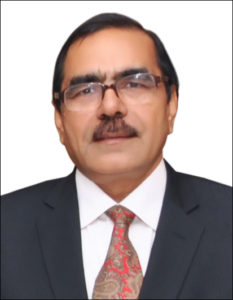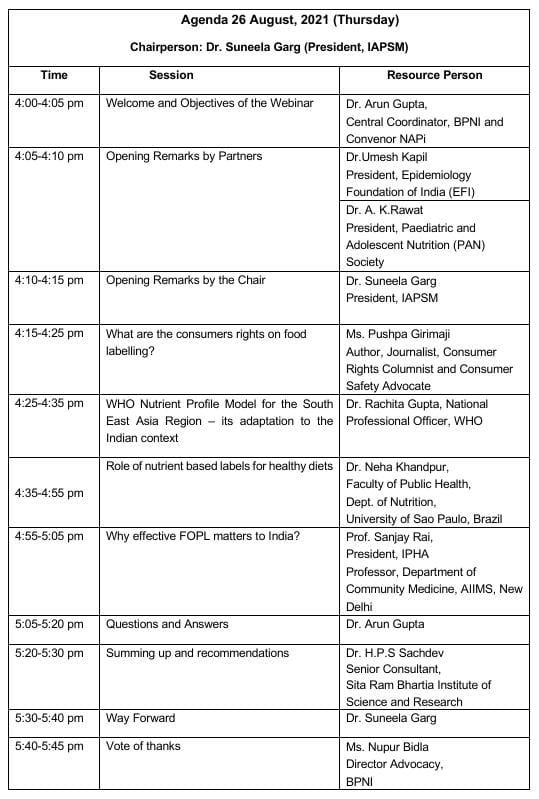
WEBINAR ON
Role of Strong Warning Labels on Unhealthy Food Products in Protecting People’s Health
Dated: 26th August 2021
In collaboration:






Breastfeeding Promotion Network of India (BPNI) in partnership with Nutrition Advocacy in Public Interest (NAPi) Pediatric and Adolescent Nutrition Society (PAN) -IAP Nutrition Chapter, Epidemiology Foundation of India (EFI), Indian Association of Preventive and Social Medicine (IAPSM) and Indian Public Health Association (IPHA).
Background
In India according to Euromonitor estimate, the sale of ultra processed food (UPF) products has increased from 2 kg per capita in 2005, to 6kg in 2019 and is expected to grow to 8kg in 2024. Similarly, beverages have gone up from less than 2 L in 2005 to about 8 L in 2019 and expected to grow to 10 L in 2024.
Highly processed food mostly plays on a trio of highly addictive components i.e., sugar, salt and fat. High sugar and salt food products (HFSS) are proven to be responsible for increasing rates of non-communicable diseases like diabetes, hypertension and heart ailments. There is plethora of evidence that consumption of ultra or highly processed foods contributes to ill health including over eating, obesity, cancers, cardiac disease, depression and all cause mortality.
Global evidence indicates that front of package labels with warnings promote healthy diets. Some Latin American and EU countries have set examples for strong front of pack labelling, A variety of options are available such as multiple traffic lights, warning signs, health star rating, keyhole symbols and 5 color nutritional labels. India needs to decide on what is most suitable for its HSSF food environment.
FOPL guidelines/rules in the right direction has the potential to encourage reformulation of the food products and could save people from big food industry’s aggressive marketing.
The WHO has prescribed thresholds for warning labels that are mostly ignored by the high sugar and salt food industry, this is because India does not have a legal binding to abide by these thresholds. Food safety Standards Authority of India (FSSAI) is working on a guideline for FOPL for these products. WHO thresholds are under considerations.
Believing that the consumer has the right to know what they are eating and how could it impact their health; the partner organisations organise this webinar on 26th August. This comes in continuation of our earlier work on UPF and Strong Nutrition Profile Modelling (NPM) for health food systems in India. To prevent NCD burden, the group recommended adapting WHO thresholds for NPM and continued to advocate to policy makers at FSSAI and MOHFW. This webinar envisages to initiate a discourse around ‘warning labels’ as the solution for informed decision by the consumers.
Objectives
- To understand the variety of front of pack labels implemented globally.
- To initiate a discourse around warning labels that facilitate informed consumption of high sugar and salt packaged food products.
- To develop recommendation for policy makers on developing, enforcing and implementing the warning labels that protect people’s health.
CHAIRPERSON

Dr. Suneela Garg,
Professor of Excellence (Dir Prof HAG),
National President IAPSM 2021
National President OMAG;
Dept of Community Medicine, MAMC, Delhi
SPEAKERS

Dr. Neha Khandpur,
Faculty of Public Health,
Dept. of Nutrition,
University of Sao Paulo, Brazil

Dr. Rachita Gupta,
National Professional Officer, Nutrition, WHO Country Office India

Ms. Pushpa Girimaji
Author, Journalist,
Consumer Rights Columnist and Consumer Safety Advocate

Prof.Sanjay Rai,
President, IPHA
Professor, Dept of Community Medicine, AIIMS, New Delhi

Dr. A K Rawat
President, Pediatric and Adolescent Nutrition (PAN) Society

Prof. Umesh Kapil,
President Epidemiology Foundation of India (EFI)

Prof. Harshpal Singh Sachdev, MD, FIAP, FAMS, FRCPCH
Senior Consultant, Sitaram Bhartia Institute of Science and Research

Dr. Arun Gupta
Convenor, NAPi/BPNI


